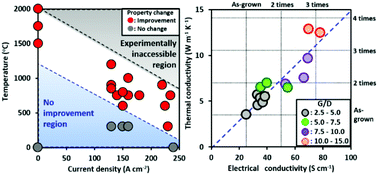Current treatment of bulk single walled carbon nanotubes to heal defects without structural change for increased electrical and thermal conductivities†
Abstract
By applying electrical current with heat, we succeeded in improving the graphitization of single walled carbon nanotubes (SWCNTs) without increasing the diameter and wall number. At 800 °C, 150 A cm−2 (1150 W cm−2) for 1 min, we achieved a 3.2-times increase in the Raman G- to D-band ratio, a 3.1-times increase in electrical conductivity (from 25.2 to 78.1 S cm−1), a 3.7-times increase in thermal conductivity (from 3.5 to 12.8 W m−1 K−1), and even a 1.7-times increase in dispersibility (from 1.7 to 2.9 mg L−1). The electrical and thermal conductivities did not only increase simultaneously, but their relative increases were identical across our experimental range that stems from defect healing without any change in diameter and wall number. In contrast, a significant increase in diameter and wall number was observed when current was not applied. These results demonstrate the importance of applying current to improve the graphitization of SWCNTs while maintaining their structure as SWCNTs.


 Please wait while we load your content...
Please wait while we load your content...